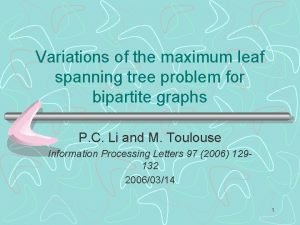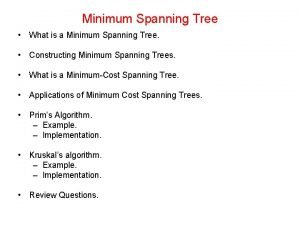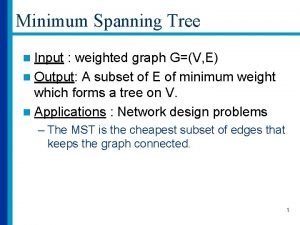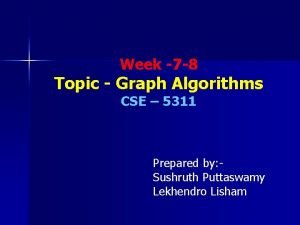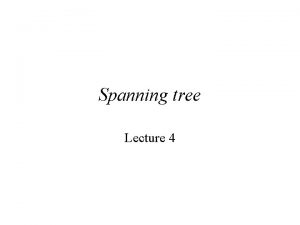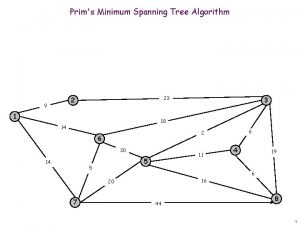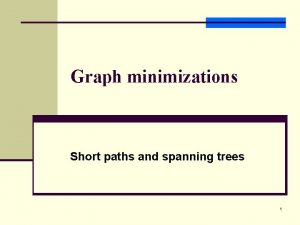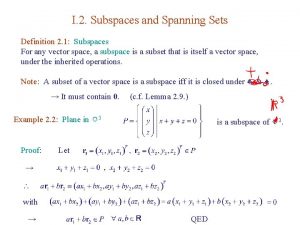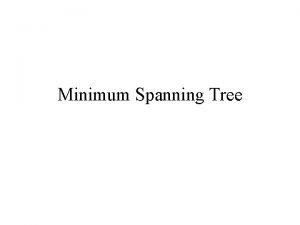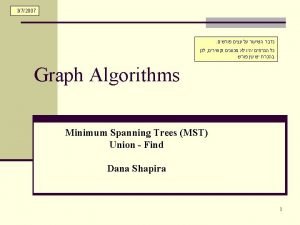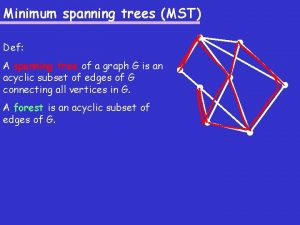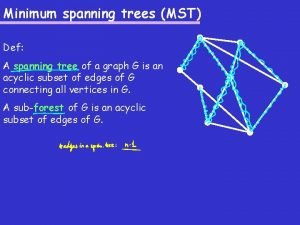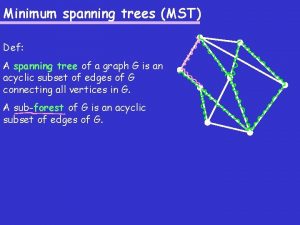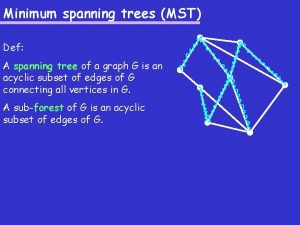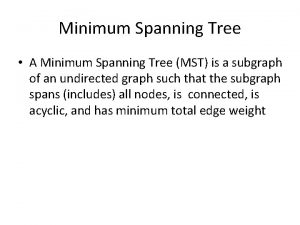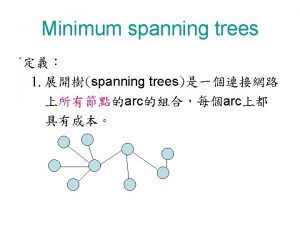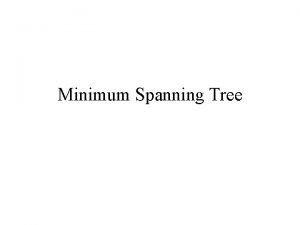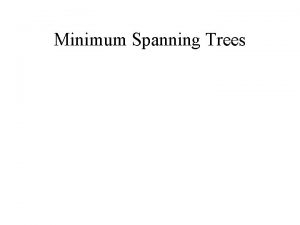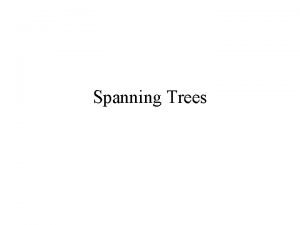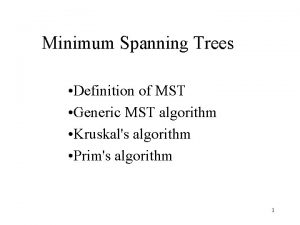Minimum spanning trees MST Def A spanning tree



























- Slides: 27

Minimum spanning trees (MST) Def: A spanning tree of a graph G is an acyclic subset of edges of G connecting all vertices in G. A sub-forest of G is an acyclic subset of edges of G.

Minimum spanning trees (MST) 1 Def: A spanning tree of a graph G is an acyclic subset of edges of G connecting all vertices in G. A sub-forest of G is an acyclic subset of edges of G. 15 7 8 5 4 3 7 1 1 2 6 2 Def: Given is a weighted (undirected) graph G=(V, E, w) where w: E ->Reals defines a weight of every edge in E. A minimum spanning tree of G is a spanning tree with the minimum total weight of edges.

Minimum spanning trees (MST) 1 Def: A spanning tree of a graph G is an acyclic subset of edges of G connecting all vertices in G. A sub-forest of G is an acyclic subset of edges of G. 15 7 8 5 4 3 7 1 1 2 6 2 Def: Given is a weighted (undirected) graph G=(V, E, w) where w: E ->Reals defines a weight of every edge in E. A minimum spanning tree of G is a spanning tree with the minimum total weight of edges.

Minimum spanning trees (MST) 1 Def: A spanning tree of a graph G is an acyclic subset of edges of G connecting all vertices in G. A sub-forest of G is an acyclic subset of edges of G. 15 7 8 5 4 3 7 1 1 2 6 2 Def: Given is a weighted (undirected) graph G=(V, E, w) where w: E ->Reals defines a weight of every edge in E. A minimum spanning tree of G is a spanning tree with the minimum total weight of edges.

Minimum spanning trees (MST) -Kruskal 1 15 7 8 5 4 3 7 1 1 2 2 6 Kruskal ( G=(V, E, w) ) 1. Let T=; 2. Sort the edges in increasing order of weight 3. For edge e do 4. If T [ e does not contain a cycle then 5. Add e to T 6. Return T

Minimum spanning trees (MST) -Kruskal Lemma: Algo is correct. 1 15 7 8 5 4 3 7 1 1 2 2 6 Kruskal ( G=(V, E, w) ) 1. Let T=; 2. Sort the edges in increasing order of weight 3. For edge e do 4. If T [ e does not contain a cycle then 5. Add e to T 6. Return T

Minimum spanning trees (MST) -Kruskal Implementation? 1 15 7 8 5 4 3 7 1 1 2 2 6 Kruskal ( G=(V, E, w) ) 1. Let T=; 2. Sort the edges in increasing order of weight 3. For edge e do 4. If T [ e does not contain a cycle then 5. Add e to T 6. Return T

Minimum spanning trees (MST) -Kruskal Implementation? - Union-Find datastructure Init (V) 1. for every vertex v do 2. boss[v]=v 3. size[v]=1 4. set[v]={v} 1 15 7 8 5 4 3 7 1 1 2 2 6 Union (u, v) 1. if size[boss[u]]>size[boss[v]] then 2. set[boss[u]]=set[boss[u]] union set[boss[v]] 3. size[boss[u]]+=size[boss[v]] 4. for every z in set[boss[v]] do 5. boss[z]=boss[u] 6. else do steps 2. -5. with u, v switched

Minimum spanning trees (MST) -Kruskal Analysis of Union-Find 1 15 Lemma: n-1 Unions take O(n log n) time 7 8 5 4 3 7 1 1 2 2 6 Union (u, v) 1. if size[boss[u]]>size[boss[v]] then 2. set[boss[u]]=set[boss[u]] union set[boss[v]] 3. size[boss[u]]+=size[boss[v]] 4. for every z in set[boss[v]] do 5. boss[z]=boss[u] 6. else do steps 2. -5. with u, v switched

Minimum spanning trees (MST) -Kruskal Analysis of Union-Find 1 15 Lemma: n-1 Unions take O(n log n) time 7 8 5 4 3 7 1 1 2 6 2 Corollary: The running time of Kruskal is: O(|E| log |E|) + O(|V| log |V|)

Minimum spanning trees (MST) - Prim ( G=(V, E, w) ) 1. Let T=; , H=; 2. For every vertex v do 3. cost[v]=1, parent[v]=null 4. Let u be a vertex 5. Update (u) 6. For i=1 to n-1 do 7. u=vertex from H of smallest cost (remove) • Add (u, parent[u]) to T • Update(u) • Return T 1 15 5 Update (u) 1. For every neighbor v of u 2. If cost[v]>w(u, v) then 3. cost[v]=w(u, v), parent[v]=u 4. If v not in H then 5. Add v to H 7 8 4 3 7 1 1 2 2 6

Minimum spanning trees (MST) - Prim ( G=(V, E, w) ) 1. Let T=; , H=; 2. For every vertex v do 3. cost[v]=1, parent[v]=null 4. Let u be a vertex 5. Update (u) 6. For i=1 to n-1 do 7. u=vertex from H of smallest cost (remove) • Add (u, parent[u]) to T • Update(u) • Return T 1 15 5 Update (u) 1. For every neighbor v of u 2. If cost[v]>w(u, v) then 3. cost[v]=w(u, v), parent[v]=u 4. If v not in H then 5. Add v to H 7 8 4 3 7 1 1 2 2 6

Minimum spanning trees (MST) - Prim Lemma: Prim is correct. 1 15 7 8 5 4 7 1 1 2 Running time: 3 2 6

Single source shortest paths -Dijkstra Input: G=(V, E, w) and a vertex s (w non-negative) Output: shortest paths from s to every other vertex 1 15 5 4 3 7 1 Can use similar idea to Prim? 7 8 1 2 2 6

Single source shortest paths -Dijkstra Input: G=(V, E, w) and a vertex s (w non-negative) Output: shortest paths from s to every other vertex 1 15 5 4 3 7 1 Can use similar idea to Prim? 7 8 1 2 2 6

Single source shortest paths -Dijkstra 1 Dijkstra ( G=(V, E, w), s ) 1. Let H=; 2. For every vertex v do 3. dist[v]=1 4. dist[s]=0 5. Update (s) 6. For i=1 to n-1 do 7. u=extract vertex from H of smallest cost 8. Update(u) • Return dist[] 15 5 Update (u) 1. For every neighbor v of u 2. If dist[v]>dist[u]+w(u, v) then 3. dist[v]=dist[u]+w(u, v) 4. If v not in H then 5. Add v to H 7 8 4 3 7 1 1 2 2 6

Single source shortest paths -Dijkstra Lemma: Dijkstra is correct. 1 15 7 8 5 4 3 7 1 1 2 2 6

All pairs shortest paths – Floyd-Warshall Input: G=(V, E, w), w non-negative Output: shortest paths between all pairs of vertices 1 15 2 7 5 9 3 7 1 1 2 2 1

All pairs shortest paths – Floyd-Warshall Input: G=(V, E, w), w non-negative Output: shortest paths between all pairs of vertices Idea 1: • Use Dijkstra from every vertex 1 15 7 8 5 4 3 7 1 1 2 2 6

All pairs shortest paths – Floyd-Warshall Input: G=(V, E, w), w non-negative Output: shortest paths between all pairs of vertices Idea 1: • Use Dijkstra from every vertex Idea 2: • How about dynamic programming? 1 15 2 7 5 9 3 7 1 1 2 2 1

All pairs shortest paths – Floyd-Warshall Heart of the algorithm: the length of the shortest path S[i, j, k] = from i to j using only vertices · k 1 15 7 8 5 4 3 7 1 1 2 2 6

All pairs shortest paths – Floyd-Warshall Heart of the algorithm: the length of the shortest path S[i, j, k] = from i to j using only vertices · k How to compute S[i, j, k] ? S[i, j, k] = 1 15 7 8 5 4 3 7 1 1 2 2 6

All pairs shortest paths – Floyd-Warshall 1 Floyd-Warshall ( G=(V, E, w) ) 15 1. For i=1 to |V| do 2. For j=1 to |V| do 5 3. S[i, j, 0] = w(i, j) 4. For k=1 to |V| do 5. For i=1 to |V| do 1 6. For j=1 to |V| do 7. S[i, j, k] = min { 8. S[i, j, k-1], 9. S[i, k, k-1]+S[k, j, k-1] } 10. Return ? S[i, j, k] = w(i, j) 7 8 4 3 7 1 2 6 2 if k = 0 max { S[i, j, k-1], S[i, k, k-1] + S[k, j, k-1] } if k > 0

Single source shortest paths – Bellman-Ford Input: directed G=(V, E, w) and a vertex s Output: • FALSE if exists reachable negative-weight cycle, • distance to every vertex, otherwise. -1 4 7 -7 5 4 3 -3 1 1 2 2 6

Single source shortest paths – Bellman-Ford Input: directed G=(V, E, w) and a vertex s Output: • FALSE if exists reachable negative-weight cycle, • distance to every vertex, otherwise. -1 4 7 -7 5 9 3 -3 1 1 2 2 6

Single source shortest paths – Bellman-Ford Input: directed G=(V, E, w) and a vertex s Output: • FALSE if exists reachable negative-weight cycle, • distance to every vertex, otherwise. -1 4 7 -7 5 9 3 -3 1 1 2 2 6

Single source shortest paths – Bellman-Ford -1 4 5 Bellman-Ford ( G=(V, E, w), s ) 1. For every vertex v 2. d[v] = 1 3. d[s]=0 4. For i=1 to |V|-1 do 5. For every edge (u, v) in E do 6. If d[v]>d[u]+w(u, v) then 7. d[v]=d[u]+w(u, v) 8. For every edge (u, v) in E do 9. If d[v]>d[u]+w(u, v) then 10. Return NEGATIVE CYCLE 11. Return d[] 7 -7 8 3 -3 1 1 2 2 6
 Minimum leaf spanning tree
Minimum leaf spanning tree Minimum cost spanning tree
Minimum cost spanning tree Dijkstra vs prim vs kruskal
Dijkstra vs prim vs kruskal Dijkstra's algorithm proof
Dijkstra's algorithm proof Minimum spanning tree definition
Minimum spanning tree definition Minimum spanning tree shortest path
Minimum spanning tree shortest path Minimum spanning tree
Minimum spanning tree Minimum spanning tree weighted graph
Minimum spanning tree weighted graph Minimum spanning tree
Minimum spanning tree Solin algorithm
Solin algorithm Minimum spanning tree
Minimum spanning tree Minimum spanning tree
Minimum spanning tree Minimum spanning tree
Minimum spanning tree Minimum spanning tree
Minimum spanning tree Subspaces and spanning sets
Subspaces and spanning sets Spanning trees
Spanning trees Absolute min and max
Absolute min and max Common spanning tree
Common spanning tree Spanning tree definition
Spanning tree definition Spanning tree
Spanning tree Contoh soal pohon biner matematika diskrit
Contoh soal pohon biner matematika diskrit Brily
Brily Udld normal vs aggressive
Udld normal vs aggressive Spanning tree algorithm in computer networks
Spanning tree algorithm in computer networks Pohon m-ary
Pohon m-ary Non-deterministic algorithm
Non-deterministic algorithm Spanning tree of a graph
Spanning tree of a graph Spanning-tree bpdu-protection
Spanning-tree bpdu-protection
